Page added on July 25, 2017
Researchers Have Been Underestimating the Cost of Wind and Solar
How should electricity from wind turbines and solar panels be evaluated? Should it be evaluated as if these devices are stand-alone devices? Or do these devices provide electricity that is of such low quality, because of its intermittency and other factors, that we should recognize the need for supporting services associated with actually putting the electricity on the grid? This question comes up in many types of evaluations, including Levelized Cost of Energy (LCOE), Energy Return on Energy Invested (EROI), Life Cycle Analysis (LCA), and Energy Payback Period (EPP).
I recently gave a talk called The Problem of Properly Evaluating Intermittent Renewable Resources (PDF) at a BioPhysical Economics Conference in Montana. As many of you know, this is the group that is concerned about Energy Returned on Energy Invested (EROI). As you might guess, my conclusion is that the current methodology is quite misleading. Wind and solar are not really stand-alone devices when it comes to providing the kind of electricity that is needed by the grid. Grid operators, utilities, and backup electricity providers must provide hidden subsidies to make the system really work.
This problem is currently not being recognized by any of the groups evaluating wind and solar, using techniques such as LCOE, EROI, LCA, and EPP. As a result, published results suggest that wind and solar are much more beneficial than they really are. The distortion affects both pricing and the amount of supposed CO2 savings.
One of the questions that came up at the conference was, “Is this distortion actually important when only a small amount of intermittent electricity is added to the grid?” For that reason, I have included discussion of this issue as well. My conclusion is that the problem of intermittency and the pricing distortions it causes is important, even at low grid penetrations. There may be some cases where intermittent renewables are helpful additions without buffering (especially when the current fuel is oil, and wind or solar can help reduce fuel usage), but there are likely to be many other instances where the costs involved greatly exceed the benefits gained. We need to be doing much more thoughtful analyses of costs and benefits in particular situations to understand exactly where intermittent resources might be helpful.
A big part of our problem is that we are dealing with variables that are “not independent.” If we add subsidized wind and solar, that act, by itself, changes the needed pricing for all of the other types of electricity. The price per kWh of supporting types of electricity needs to rise, because their EROIs fall as they are used in a less efficient manner. This same problem affects all of the other pricing approaches as well, including LCOE. Thus, our current pricing approaches make intermittent wind and solar look much more beneficial than they really are.
A clear workaround for this non-independence problem is to look primarily at the cost (in terms of EROI or LCOE) in which wind and solar are part of overall “packages” that produce grid-quality electricity, at the locations where they are needed. If we can find solutions on this basis, there would seem to be much more of a chance that wind and solar could be ramped up to a significant share of total electricity. The “problem” is that there is a lower bound on an acceptable EROI (probably 10:1, but possibly as low as 3:1 based on the work of Charles Hall). This is somewhat equivalent to an upper bound on the affordable cost of electricity using LCOE.
This means that if we really expect to scale wind and solar, we probably need to be creating packages of grid-quality electricity (wind or solar, supplemented by various devices to create grid quality electricity) at an acceptably high EROI. This is very similar to a requirement that wind or solar energy, including all of the necessary adjustments to bring them to grid quality, be available at a suitably low dollar cost–probably not too different from today’s wholesale cost of electricity. EROI theory would strongly suggest that energy costs for an economy cannot rise dramatically, without a huge problem for the economy. Hiding rising energy costs with government subsidies cannot fix this problem.
Distortions Become Material Very Early
If we look at recently published information about how much intermittent electricity is being added to the electric grid, the amounts are surprisingly small. Overall, worldwide, the amount of electricity generated by a combination of wind and solar (nearly all of it intermittent) was 5.2% in 2016. On an area by area basis, the percentages of wind and solar are as shown in Figure 1.
Figure 1. Wind and solar as a share of 2016 electricity generation, based on BP Statistical Review of World Energy 2017. World total is not shown, but is very close to the percentage shown for China.
There are two reasons why these percentages are lower than a person might expect. One reason is that the figures usually quoted are the amounts of “generating capacity” added by wind and solar, and these are nearly always higher than the amount of actual electricity supply added, because wind and solar “capacity” tend to be lightly used.
The other reason that the percentages on Figure 1 are lower than we might expect is because the places that have unusually high concentrations of wind and solar generation (examples: Germany, Denmark, and California) tend to depend on a combination of (a) generous subsidy programs, (b) the availability of inexpensive balancing power from elsewhere and (c) the generosity of neighbors in taking unwanted electricity and adding it to their electric grids at low prices.
As greater amounts of intermittent electricity are added, the availability of inexpensive balancing capacity (for example, from hydroelectric from Norway and Sweden) quickly gets exhausted, and neighbors become more and more unhappy with the amounts of unwanted excess generation being dumped on their grids. Denmark has found that the dollar amount of subsidies needs to rise, year after year, if it is to continue its intermittent renewables program.
One of the major issues with adding intermittent renewables to the electric grid is that doing so distorts wholesale electricity pricing. Solar energy tends to cut mid-day peaks in electricity price, making it less economic for “peaking plants” (natural gas electricity plants that provide electricity only when prices are very high) to stay open. At times, prices may turn negative, if the total amount of wind and solar produced at a given time is greater than the overall amount of electricity required by customers. This happens because intermittent electricity is generally given priority on the grid, whether price signals indicate that it is needed or not. A combination of these problems tends to make backup generation unprofitable unless subsidies are provided. If peaking plants and other backup are still required, but need to operate fewer hours, subsidies must be provided so that the plants can afford to hire year-around staff, and pay their ongoing fixed expenses.
If we think of the new electricity demand as being “normal” demand, adjusted by the actual, fairly random, wind and solar generation, the new demand pattern ends up having many anomalies. One of the anomalies is that required prices become negative at times when wind and solar generation are high, but the grid has no need for them. This tends to happen first on weekends in the spring and fall, when electricity demand is low. As the share of intermittent electricity grows, the problem with negative prices becomes greater and greater.
The other major anomaly is the need for a lot of quick “ramp up” and “ramp down” capacity. One time this typically happens is at sunset, when demand is high (people cooking their dinners) but a large amount of solar electricity disappears because of the setting of the sun. For wind, rapid ramp ups and downs seem to be related to thunderstorms and other storm conditions. California and Australia are both adding big battery systems, built by Tesla, to help deal with rapid ramp-up and ramp-down problems.
There is a lot of work on “smart grids” being done, but this work does not address the particular problems brought on by adding wind and solar. In particular, smart grids do not move demand from summer and winter (when demand is normally high) to spring and fall (when demand is normally low). Smart grids and time of day pricing aren’t very good at fixing the rapid ramping problem, either, especially when these problems are weather related.
The one place where time of day pricing can perhaps be somewhat helpful is in lessening the rapid ramping problem of solar at sunset. One fix that is currently being tried is offering the highest wholesale electricity prices in the evening (6:00 pm to 9:00 pm), rather than earlier in the day. This approach encourages those adding new solar energy generation to add their panels facing west, rather than south, so as to better match demand. Doing this is less efficient from the point of view of the total electricity generated by the panels (and thus lowers EROIs of the solar panels), but helps prevent some of the rapid ramping problem at sunset. It also gets some of the generation moved from the middle of day to the evening, when it better matches “demand.”
In theory, the high prices from 6:00 pm to 9:00 pm might encourage consumers to move some of their electricity usage (cooking dinner, watching television, running air conditioning) until after 9:00 pm. But, as a practical matter, it is difficult to move very much of residential demand to the desired time slots based on price. In theory, demand could also be moved from summer and winter to spring and fall based on electricity price, but it is hard to think of changes that families could easily make that would allow this change to happen.
With the strange demand pattern that occurs when intermittent renewables are added, standard pricing approaches (based on marginal costs) tend to produce wholesale electricity prices that are too low for electricity produced by natural gas, coal, and nuclear providers. In fact, wholesale electricity rates for supporting providers tend to diverge further and further from what is needed, as more and more intermittent electricity is added. The dotted line on Figure 2 illustrates the falling wholesale electricity prices that have been occurring in Europe, even as retail residential electricity prices are rising.
Figure 2. European residential electricity prices have risen, even as wholesale electricity prices (dotted line) have fallen. Chart by Paul-Frederik Bach.
The marginal pricing scheme gives little guidance as to how much backup generation is really needed. It is therefore left up to governments and local electricity oversight groups to figure out how to compensate for the known pricing problem. Some provide subsidies to non-intermittent producers; others do not.
To complicate matters further, electricity consumption has been falling rapidly in countries whose economies are depressed. Adding wind and solar further reduces needed natural gas, coal, and nuclear generation. Some countries may let these producers collapse; others may subsidize them, as a jobs-creation program, whether this backup generation is needed or not.
Of course, if a single payer is responsible for both intermittent and other electricity programs, a combined rate can be set that is high enough for the costs of both intermittent electricity and backup generation, eliminating the pricing problem, from the point of view of electricity providers. The question then becomes, “Will the new higher electricity prices be affordable by consumers?”
The recently published IEA World Energy Investment Report 2017 provides information on a number of developing problems:
“Network investment remains robust for now, but worries have emerged in several regions about the prospect of a “utility death spiral” as the long-term economic viability of grid investments diminishes. The still widespread regulatory practice of remunerating fixed network assets on the basis of a variable per kWh charge is poorly suited for a power system with a large amount of decentralised solar PV and storage capacity.”
The IEA investment report notes that in China, 10% of solar PV and 17% of wind generation were curtailed in 2016, even though previous problems with lack of transmission had been fixed. Figure 1 shows China’s electricity from wind and solar amounts to only 5.0% of its total electricity consumption in 2016.
Regarding India, the IEA report says, “More flexible conventional capacity, including gas-fired plants, better connections with hydro resources and investment in battery storage will be needed to support continued growth in solar power.” India’s intermittent electricity amounted to only 4.1% of total electricity supply in 2016.
In Europe, a spike in electricity prices to a 10-year high took place in January 2017, when both wind and solar output were low, and the temperature was unusually cold. And as previously mentioned, California and South Australia have found it necessary to add Tesla batteries to handle rapid ramp-ups and ramp-downs. Australia is also adding large amounts of transmission that would not have been needed, if coal generating plants had continued to provide services in South Australia.
None of the costs related to intermittency workarounds are currently being included in EROI analyses. They are generally not being included in analyses of other kinds, either, such as LCOE. In my opinion, the time has already arrived when analyses need to be performed on a much broader basis than in the past, so as to better capture the true cost of adding intermittent electricity.
–
–
–
Of course, as we saw in the introduction, worldwide electricity supply is only about 5% wind and solar. The only parts of the world that were much above 5% in 2016 were Europe, which was at 11.3% in 2016 and the United States, which was at 6.6%.
There has been a lot of talk about electrical systems being operated entirely by renewables (such as hydroelectric, wind, solar, and burned biomass), but these do not exist in practice, as far as I know. Trying to replace total energy consumption, including oil and natural gas usage, would be an even bigger problem.
The amount of electricity required by consumers varies considerably over the course of a year. Electricity demand tends to be higher on weekdays than on weekends, when factories and schools are often closed. There is usually a “peak” in demand in winter, when it is unusually cold, and second peak in summer, when it is unusually hot. During the 24-hour day, demand tends to be lowest at night. During the year, the lowest demand typically comes on weekends in the spring and fall.
If intermittent electricity from W&S is given first priority on the electric grid, the resulting “net” demand is far more variable than the original demand pattern based on customer usage. This increasingly variable demand tends to become more and more difficult to handle, as the percentage of intermittent electricity added to the grid rises.
EROI is nearly always calculated at the level of the solar panel or wind turbine, together with a regular inverter and whatever equipment is used to hold the device in place. This calculation does not consider all of the costs in getting electricity to the right location, and up to grid quality. If we move clockwise around the diagram, we see some of the problems as the percentage of W&S increases.
One invention is smart inverters, which are used to bring the quality of the electrical output up closer to grid quality, apart from the intermittency problems. Germany has retrofitted solar PV with these, because of problems it encountered using only “regular” inverters. Upgrading to smart inverters would be a cost not generally included in EROI or LCOE calculations.
The next problem illustrated in Slide 6 is the fact that the pricing system does not work for any fuel, if wind and solar are given priority on the electric grid. The marginal cost approach that is usually used gives too low a wholesale price for every producer subject to this pricing scheme. The result is a pricing system that gives misleadingly low price signals. Regulators are generally aware of this issue, but don’t have a good way of fixing it. Capacity payments are used in some places as an attempted workaround, but it is not clear that such payments really solve the problem.
It is less obvious that in addition to giving too low pricing indications for electricity, the current marginal cost pricing approach indirectly gives artificially low price indications regarding the required prices for natural gas and coal as fuels. As a result of this and other forces acting in the same directions, we end up with a rather bizarre situation: (a) Natural gas and and coal prices tend to fall below their cost of production. (b) At the same time, nuclear electricity generating plants are being forced to close, because they cannot afford to compete with the artificially low price of electricity produced by the very low-priced natural gas and coal. The whole system tends to be pushed toward collapse by misleadingly low wholesale electricity prices.
Slide 6 also shows some of the problems that seem to start arising as more intermittent electricity is added. Once new long distance transmission lines are added, it changes the nature of the whole “game.” It becomes easier to rely on generation added by a neighbor; any generation that a country might add becomes more attractive to a neighbor. As long as there is plenty of electricity to go around, everything goes well. When there are shortages, then arguments begin to arise. Arguments such as these may destabilize the Eurozone.
One thing I did not mention in this chart is the increasing need to pay intermittent grid providers not to produce electricity when there is an oversupply of electricity. In the UK, the amount of these payments was over 1 million pounds a week in 2015. I mentioned previously that in China, 17% of wind generation and 10% of solar PV generation were being curtailed in 2016. EROI calculations do not consider this possibility; they assume that 100% of the electricity that is generated can, in fact, be used by the system.
The pricing system no longer works because W&S are added whenever they become available, in preference to other generation. In many ways, the pricing system is like our appetite for food. Usually, we eat when we are hungry, and the food we eat reduces our appetite. W&S are added to the system with total disregard for whether the system needs it or not, leaving the other electricity producers to try to fix up the mess, using the false pricing signals they get. The IEA’s 2017 Investment Report recommends that countries develop new pricing schemes that correct the problems, but it is not clear that this is actually possible without correcting the hidden subsidies.
Why add more electricity supply, if there is a chance that you can use the new supply added by your neighbor?
South Australia had two recent major outages–both partly related to adding large amounts of wind and solar to the electric grid, and the loss of its last two coal-fired electricity generation plants. The first big outage came during a weather event. The second big outage occurred when temperatures were very high during summer, and because of this, electricity demand was very high.
One planned workaround for supply shortages was natural gas. Unfortunately, South Australia doesn’t actually have a very good natural gas supply to operate its units generating electricity from natural gas. Thus, the available natural gas generators could not really respond as hoped, except at very high prices. Some changes are now being made, including a planned Tesla battery system. With the changes being made, there are reports of electricity rate increases of up to 120% for businesses in South Australia.
The irony of the situation is that Australia is a major natural gas exporter. Businesses expected that they could make more money selling the natural gas abroad as LNG than they could by providing natural gas to the citizens of South Australia. These exports are now being curbed, to try to help fix the South Australia natural gas problem.
These issues point out how interconnected all of the different types of electricity generation are, and how quickly a situation can become a local crisis, if regulators simply assume “market forces will provide a solution.”
An expert panel in Australia has recommended an approach similar to this. It simply becomes too difficult to operate a system with built-in subsidies.
–
Timing makes a difference. The payments that are made for interest need to be made, directly or indirectly, with future goods and services that can only be made using energy products. Thus, they also require the use of energy products.
–
There is a real difference between (a) looking at the actual operating experiences of an existing oil and gas or coal company, and (b) guessing what the future operating experience of a system operated by wind panels and solar panels might be. The tendency is to guess low, when it comes to envisioning what future problems may arise.
It is not just the wind turbines and solar panels that will need to be replaced over time; it is all of the supporting devices that need to be kept in good repair and replaced over time. Furthermore, the electric grid is dependent on oil for its upkeep. If oil becomes a problem, there is a real danger that the electric grid will become unusable, and with it, electricity that is generally distributed by the grid, including wind and solar.
–
Economies and humans are both self-organized systems that depend on energy consumption for their existence. They have many other characteristics in common as well.
We know that with humans, we really need to examine how a new medicine or a change in diet works in practice. For one thing, medicines and diets aren’t necessarily used as planned. Unexpected long-term changes occur that we could not anticipate.
The same kinds of problems occur when wind and solar are added to a grid system. We really have to look at what is happening to see the full picture.
Anyone who has followed the news knows about medicine’s long history of announcements followed by retractions.
A fairly similar situation can be expected to happen with proposed energy solutions.
There is a whole package of costs and a whole range of direct and indirect outcomes to consider.
As far as I know, none of the attempts at producing a system that operates on 100% renewable energy have been a success. There has been some reductions in fossil fuel usage, but at a high cost.
A 2013 Weissabach et al. EROI analysis examines a situation with partial buffering of wind and solar (approximately 10 days worth of buffering). It leaves out several other costs of bringing wind and solar up to grid quality electricity, such as extra long distance transmission costs, and more significant buffering to allow transferring electricity produced in spring and fall to be saved for summer or winter. These authors calculated a partially buffered EROI of 4:1 for wind, and a partially buffered EROI range of 1.5:1 to 2.3:1 for solar PV.
Of course, more investigation, including looking at the full package of needed devices to provide non-intermittent electricity of grid quality, is really needed for particular situations. Improvements in technology would tend to raise EROI indications; adding more supplemental devices to bring electricity to grid quality would tend to reduce EROI indications.
If the cutoff for being able to maintain a modern society is 10:1, as mentioned earlier, then wind and solar PV would both seem to fall far below the required EROI cutoff, if they are to be used in quantity.
If, as Hall believes, an EROI as low as 3:1 might be useful, then there is a possibility that some wind energy would be helpful, especially if a particular wind location has a very high capacity factor (can generate electricity a large share of the time), and if pricing problems can be handled adequately. The EROI of solar PV would probably still be too low in most applications. In any event, we need to be examining situations more closely, instead of simply assuming that hidden subsidies can be counted on indefinitely.
84 Comments on "Researchers Have Been Underestimating the Cost of Wind and Solar"

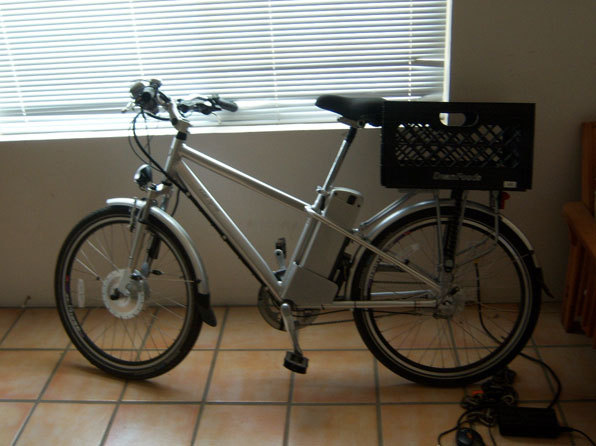

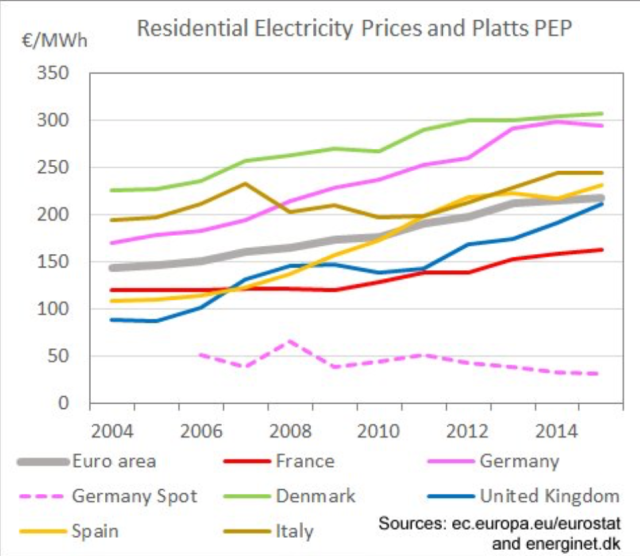




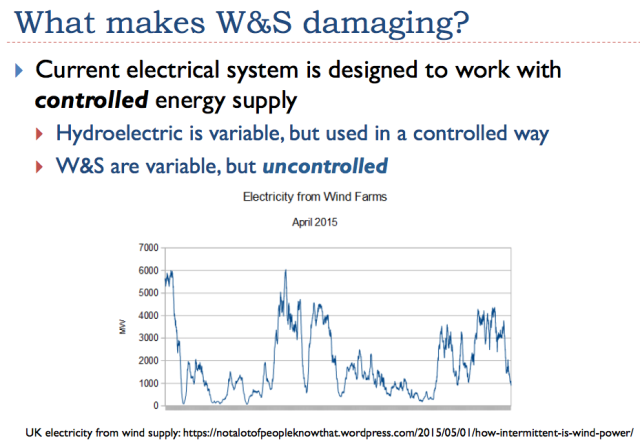

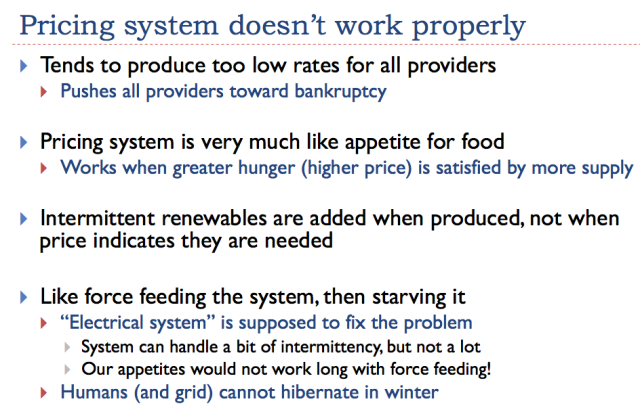

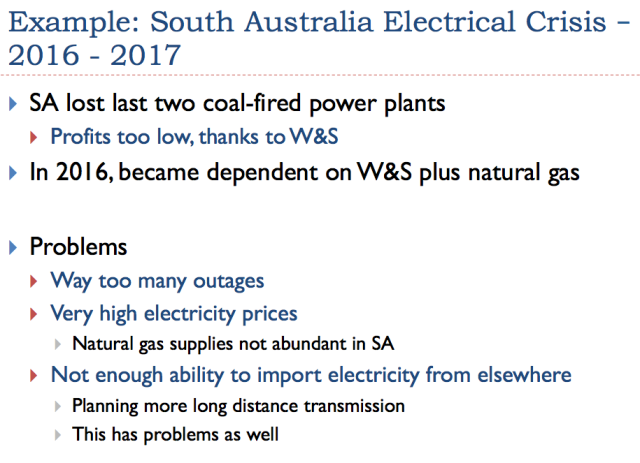


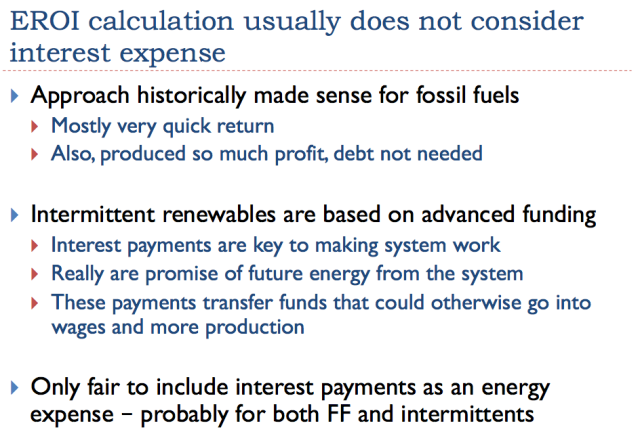



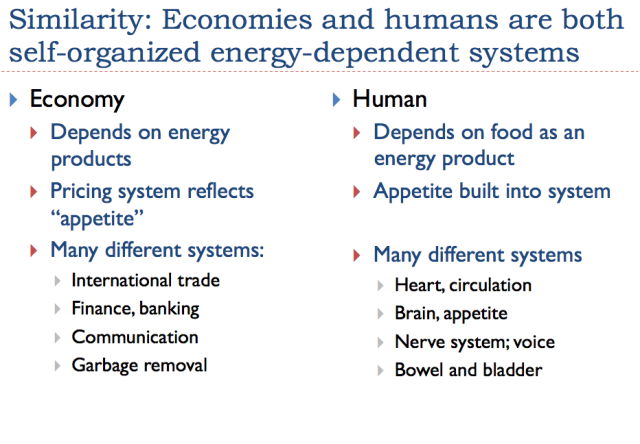




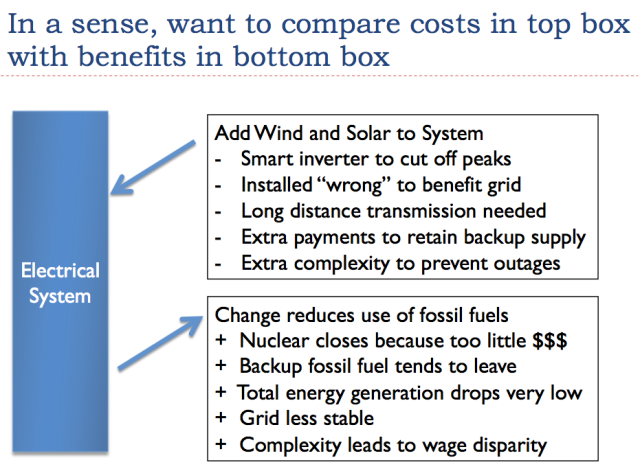
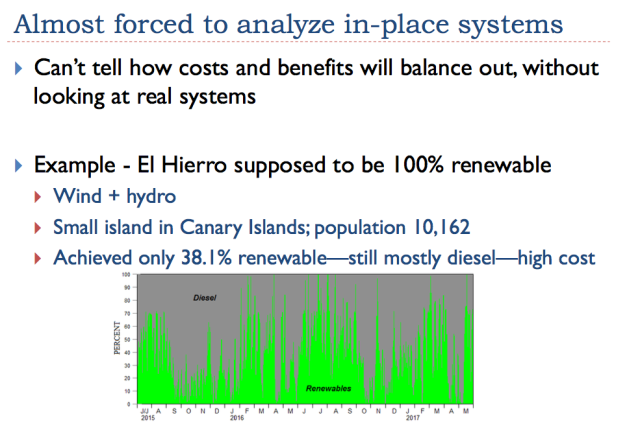
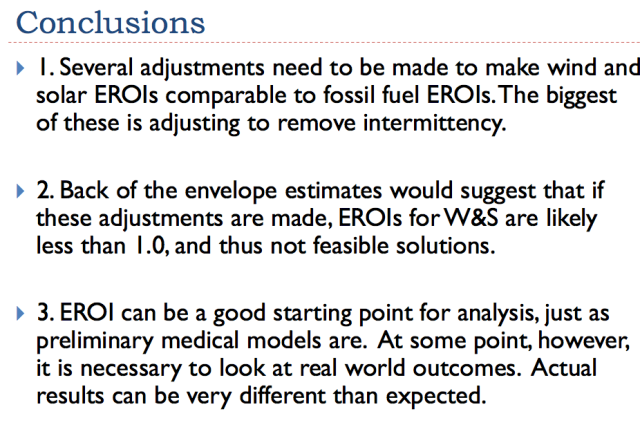
Cloggie on Tue, 25th Jul 2017 7:24 am
Oh my, the Gail Tverberg/Charly Hall “Con’t Do Society” at large again.
https://deepresource.wordpress.com/2017/06/12/report-upbeat-assessment-european-offshore-wind/
– Between 2,600 and 6,000 TWh/year can be generated at a cost of €65/MWh or below, corresponding with between 80% and 180% of Europe’s electricity demand with 2030 technology.
– Of that amount 25% of the EU’s electricity demand could be met at an average of €54/MWh in the most favorable locations.
Storage of course is essential and a challenge, more so than solar panel and wind turbine technology, that has to a great extent matured.
But there is absolutely no reason to assume that in the coming three decades this problem will not find a technical solution (pumped hydro, compressed air, ammonia, hydrogen, etc, etc).
eugene on Tue, 25th Jul 2017 7:46 am
I have always viewed the solar/wind issue as absurd. It’s based on “back of an envelope” reasoning with a whole lot of faith based thinking. Faith based in that “we will develop, it will happen”. We do not have the battery issues solved. In fact, other than limited applications, we don’t have any of it solved.
Jan on Tue, 25th Jul 2017 7:55 am
Cloggie
Pumped hydro will not be a solution found in the next 3 decades, cos it has already been found and it’s limitations are well known.
Compressed Air! really?
The modern battery has been around since 1800.
https://en.wikipedia.org/wiki/History_of_the_battery
The best so far is Tesla powerwall.
https://www.tesla.com/en_GB/powerwall
You need 2 of them to power your home for a single day.
In the U.K. wind power has on many occasions in winter been as low as 2% of daily need.
Solar in November, December, January is often less than 3% of daily demand.
Therefore 95% of factories, offices, shops, hospitals and homes would need battery backup.
How many batteries would one hospital need?
RD on Tue, 25th Jul 2017 8:31 am
That may be the best read I’ve seen on this site.
rockman on Tue, 25th Jul 2017 8:31 am
Nice enough generalizations. But the economics and utility of wind/soled is grid specific. What works great in Texas may not be practical in Ohio. And this is true on several levels. First, the economics of construction. A huge variable if the new alt is being built to replace ff fired plants (which have already recovered their construction costs and alts that are adding needed capacity and not replacing existing ff plants. That is the case in Texas: with our growing demand if wind had not boomed here more NG/coal fired plants would have been. Thus the new infrastructure economics of alt vs ff were head to head. Of course from an operations stand point wind/solar economics easily built ff. Especially if one projects a significant increase in future NG prices.
And here’s a different perspective: ff fired plants are also an “intermittent” source of energy. Not by a physical limitation but by economic choice: when the winds are blowing in Texas we have less ff burned: at peak wind our coal fired sources can drop from more then 35% to less the 15%. There have actual been short term events when ff sources could not satisfy demand while wind was at a peak supplying as much as 40% of statewide demand instead of closer to the normal 10%. Thus saving us from blackouts during unusually severe cold weather.
And now as solar begins to ramp up it has the same potential to save us from blackouts during the summer when AC demand during the day competes significant with commercial demand. Decades ago the state almost “went to war” with the feds that forced Texas NG to be shipped out of state “starving” some of our power plants. Thus causing Texas businesses to shut down for short periods. There was even semi-serious talk of the Texas Guard physically shutting down pipelines at the state’s border. Imagine in the future if NG supplies become less abundant.
One cannot argue that from a daily operations cost wind/solar beat coal and especially NG. imagine the differential if future NG cost increase 3X to 4X as they were not that long ago. Thanks to low NG prices, abundant local lignite and word class wind Texas electricity rates puts us at #10 compared to over states. In fact only about 15% higher the #1 Washington with its cheap hydro. Not bad considering Texas consumes more electricity then any other states including consuming 50% more then #2 CA.
Texas is somewhat unique in our wind/solar resources. OTOH we also have abundant and relatively inexpensive ff resources the alts have to compete against. Generalities about the viability of alt energy sources ignores the unique circumstances that vary greatly from state to state. Which includes a state’s grid capability to handle alt expansion. A capability that was greatly enhanced in Texas by spending $7 BILLION in tax payer money to accommodate wind power expansion.
IOW what’s good for Texans ain’t necessarily good for everyone.
Jan on Tue, 25th Jul 2017 8:36 am
Germany is going all out for renewables.
Since 2005, Net installed capacity have gone from 18 to 47 Gigawatts for wind and from 2 to 41 Gigawatts for solar.
Yet electricity from coal has fallen only a tiny amount in that time.
https://www.energy-charts.de/energy.htm?source=all-sources&period=annual&year=2016
The reality is solar does not work after sunset and wind works as and when.
There are no storage systems to meet the needs of entire countries. That is why the article below should not be a surprise to anyone.
http://instituteforenergyresearch.org/analysis/france-germany-turn-coal/
Cloggie on Tue, 25th Jul 2017 9:59 am
@Jan
Pumped hydro will not be a solution found in the next 3 decades, cos it has already been found and it’s limitations are well known.
You apparently missed that countries like the UK, Netherlands, Germany and Denmark have for years embarked on a strategy of using Norway (with Norwegian consent) as its battery. Nothing beats pumped hydro in cost. Round-trip efficiency 80%
https://deepresource.wordpress.com/2012/10/17/norway-wants-to-become-europes-battery/
https://deepresource.wordpress.com/2013/06/13/norway-europes-green-battery/
https://deepresource.wordpress.com/2013/06/15/norned/
https://deepresource.wordpress.com/2015/03/30/green-light-for-british-norwegian-interconnector/
https://deepresource.wordpress.com/2013/07/28/european-supergrid-subsea-cables-inventory-plans/
Cloggie on Tue, 25th Jul 2017 10:08 am
@Jan
Compressed Air! really?
Yep, compressed air.
https://deepresource.wordpress.com/2017/04/08/ricas-2020-compressed-air-storage/
https://deepresource.wordpress.com/2014/12/10/compressed-air-energy-storage/
Projects are underway to increase efficiency up to 70-80%. Old abandoned mines can be used for that purpose, so you can store your energy locally rather than sending it to Norway.
The best so far is Tesla powerwall.
The Tesla is expensive. The Chevrolet Bolt meanwhile has a 60 kWh battery that comes at $145/kWh. But it is still much cheaper to store gigantic water volumes in a lake, high in the mountains. This is a far smaller environmental footprint that large amount of chemicals, necessary for batteries.
Therefore 95% of factories, offices, shops, hospitals and homes would need battery backup. How many batteries would one hospital need?
Batteries are fine for cars/trucks/agricultural equipment, etc or 24h coverage of households who generate solar power for themselves, for the rest, not so much.
For the rest ruse hydrogen…
https://deepresource.wordpress.com/2017/04/23/cost-hydrogen-from-renewable-energy/
…best in liquid form:
https://deepresource.wordpress.com/2017/07/08/formic-acid-as-car-fuel/
…or use ammonia:
https://deepresource.wordpress.com/2017/04/08/ammonia-as-storage-medium/
Go Speed Racer on Tue, 25th Jul 2017 10:53 am
Forget windmills. Dumb idea. This article finally
proving it. Let’s put sofa’s, tires, and
old mattresses into the boilers at the coal plant.
We can also start digging up old landfills and
burn it like coal.
Don’t use any stack scrubbers, wanna see clouds
of black smoke. This will Make America Great Again.
Apneaman on Tue, 25th Jul 2017 11:47 am
clog, here’s some more on your beloved “greening”.
“They say warmer conditions are encouraging algae to grow and darken the surface.
Dark ice absorbs more solar radiation than clean white ice so warms up and melts more rapidly”
Sea level fears as Greenland darkens
http://www.bbc.com/news/science-environment-40686984
Jan on Tue, 25th Jul 2017 12:29 pm
Cloggie
Norway has a potential of 214Twh
https://www.regjeringen.no/contentassets/fd89d9e2c39a4ac2b9c9a95bf156089a/facts_2015_energy_and_water_web.pdf
That is LESS than German coal production.
https://www.cleanenergywire.org/factsheets/germanys-energy-consumption-and-power-mix-charts
The UK uses 309 Twh, coal and gas make up over half of production.
https://www.gov.uk/government/uploads/system/uploads/attachment_data/file/622771/Electricity.pdf
If you bothered to do even basic calculations you would realise that Norway could not even supply all of Germany’s needs if Germany had no gas and coal.
Apneaman on Tue, 25th Jul 2017 1:01 pm
PROGRESS!!!!
“Fossil fuels accounted for 81% of the world’s energy consumption in 1987. Thirty years later it’s still 81%.”
https://www.axios.com/the-world-needs-clean-coal-but-cant-get-it-2463070285.html
Outcast_Searcher on Tue, 25th Jul 2017 1:15 pm
I generally agree that the greens, especially the pure green periodicals/websites, tend to ignore many costs and assume that technology will “take care of all issues”, “real soon now”.
There are real world costs like installation for solar, maintenance, and batteries for storage (i.e. Tesla Powerwall as Jan mentioned above). Powerwall will “work” but it IS expensive, even if costs decline considerably. And if you want to keep a week of power for a cloudy/cold envirnmentm that will be REAL expensive, so getting off the grid seems a pipe dream for most (vs. greatly reducing the need for the grid on normal sunny days).
Not that any of this makes wind or solar “bad”, but it would be MOST helpful if both sides would quit obfuscating and lying to fulfill some sort of political agenda, and we could get some basic truth out to the masses.
People are capable of doing arithmetic, planning, and making decisions. But they can’t do that WELL, if they don’t have reasonable accurate, realistic data/projections to work with.
This is an example of an area which I would think the government should fulfill. However, with the inconsistency of funding and attitude across administrations, at least in the US, hoping for consistency there seems to be another pipe dream.
Meanwhile, I’m rooting for things like the Tesla Powerwall and Solar tiles. But so far, the real world costs for a system for my 1200ish SF ranch (1st floor) in central KY, with power for a few days look SHOCKINGLY high — like near $100,000.
With me using only about 500 KWH a month average and paying only $60ish average for my monthly electricity bill, the ONLY way I’d even consider that would be a political agenda / green thing. For the costs, I’d have to be a MORON to do that until the costs of the (real world) solar equipment from Tesla come WAY DOWN.
Simon on Tue, 25th Jul 2017 1:27 pm
if the amount of electricity being consumed is still 81%, this means that the problems now are the same as they were.
As for solar going off at night, it will come as a surprise that we know this, so you don’t need a peaker to cover this known drop, just cycle up a CCGT.
As for being uneconomical BS the SRMC of a bid has the startup costs smeared into it, so, you should not lose money.
The rest is covered by incs and decs.
if your big throbbing thermal plant cannot, then shut it down, the price will soon change, and you will make money on the BM.
As some regions are great at baseload they can sell to variable regions, what they need to do,isrun the maths to make the sell cover the decrease when they buy
Dredd on Tue, 25th Jul 2017 1:44 pm
Oil-Qaeda has been underestimating the cost of using fossil fuels.
baha on Tue, 25th Jul 2017 1:52 pm
The grid is not an entity itself. It is a group of users that have different requirements. Each user can find another way on his own. We do not serve the grid, it serves us!
Otherwise this is all a bunch of financial bullshit. Does anyone mention the price of a livable planet?
Davy on Tue, 25th Jul 2017 1:58 pm
This really is now a matter of economics and behavior. Technically many of the issues have been addressed. Manufacturing processes are bringing cost down. Human skills are ramping up. A critical mass of capabilities are coalescing. We have an issue with behavior. We want to replace the fossil fuel way with a renewable way. We need to combine conservation and better energy usage behavior. That becomes an issue of markets. Markets are a racket so we get into a grey area of profit taking moving good public policy. We have the two energy systems competing and they should be supportive. It should not be a matter of decimating fossil fuels it is a matter of transitioning wisely.
The biggest issue is the rich poor divide. Renewables are a rich man’s niche except where it is a matter of public policy. Public policy is not enough to make a significant transition effort. It must be an all of the above type effort. A significant amount of people will never be able to pay these cost. Governments are finding their budgets underfunded now how are they going to make their budgets go further with these new effort? If we have an economic down turn this whole renewable effort will be stopped in its track.
This is something we should do because it is more sustainable, resilient, and adds value to our living arrangements. It is not cheap and it is not going to be easy because people are not excited by it like they are about buying a new car or house. How can they get overly excited when they already have plenty of energy and for the most part relatively cheap energy? A crisis might change these attitudes but will we survive a crisis? We have so many issues now a crisis may tip us over into a cascading decline. This is a very tough topic but one that is vital.
Apneaman on Tue, 25th Jul 2017 2:10 pm
https://www.youtube.com/watch?v=0U2kA99A6Oo
Cloggie on Tue, 25th Jul 2017 2:47 pm
Jan says:
Norway has a potential of 214Twh. That is LESS than German coal production. The UK uses 309 Twh, coal and gas make up over half of production. If you bothered to do even basic calculations you would realise that Norway could not even supply all of Germany’s needs if Germany had no gas and coal.
What is the point you are making? Nobody suggest that Norwegian hydropower will be supplied to Germany or the UK.
We were discussing STORAGE, remember? The idea is that North Sea countries supply excess renewable energy to Norway, that uses the energy to pump water upwards to its many mountains lakes. And when the North Sea countries are in need of energy, Norway will be so kind to let the water flow down again and generate electricity, it sends to the UK, etc.
Current Norwegian storage capacity is 84 TWh, which is 1/6 of the German yearly electricity consumption. The Norwegian storage capacity can be expanded to a theoretical max of 600 TWh, but a more realistic figure is 200 TWh.
I have a figure in my head that that would be roughly 18 days of total EU consumption, a very significant buffer and substantial part of the solution of the storage problem.
Cloggie on Tue, 25th Jul 2017 3:23 pm
Scotland fortunately didn’t listen to Gail Tverberg and Charles Hall and during the first half of 2017 generated 124% of its electricity consumption:
https://cleantechnica.com/2017/07/24/record-june-wind-yields-record-six-months-scotland-wind-energy/
Scotland could be fossil fuel free as early as 2030:
https://www.theguardian.com/environment/2015/jan/05/scotland-fossil-fuel-free-by-2030-says-report
#ScotlandRulesTheSkies
Scotland seems to be in a position to follow the lead of Norway and forbid the selling of new gasoline cars as of 2025.
Antius on Tue, 25th Jul 2017 3:38 pm
Intermittent renewable energy is basically dumped onto the grid when it is available. This robs other producers of market share pushing them out of business, at the same time as relying on them to provide backup power.
The way around this is to insist that all power plants generating for the grid are fully dispatchable. That way, renewable energy providers must deal with intermittency at source.
Antius on Tue, 25th Jul 2017 3:45 pm
‘Scotland fortunately didn’t listen to Gail Tverberg and Charles Hall and during the first half of 2017 generated 124% of its electricity consumption:’
No they didn’t. Wind turbines in Scotland dumped the equivalent of 124% of Scotland’s power consumption onto the UK grid and then imported most of their power from England. Scotland represents about 8% of UK power consumption.
Cloggie on Tue, 25th Jul 2017 3:51 pm
Well Antius, if you say A, you need to say B as well:
https://www.theguardian.com/environment/2016/nov/17/uk-boris-johnson-ratifies-paris-climate-agreement
rockman on Tue, 25th Jul 2017 3:57 pm
baha – “The grid is not an entity itself. It is a group of users that have different requirements.” And thus a big reason Texas alt can’t be compared to other states: our grid is THE entity that calls all the sots thru its manager: ERCOT. It is a consortium of generators, transmission companies and distribution companies coordinated for their mutual benefit but still keeps electricity consumer interests as the primary goal. And all thanks to Texas having an independent grid from the rest of the country.
I see your point as the biggest hurdle to developing such a system in either the eastern or western grids: too many conflicting interests between multiple players in multiple states.
peakyeast on Tue, 25th Jul 2017 4:19 pm
The electrical grid will have to implement storage in some way or another – and these will, of course, get paid. When I look at my electricity bill and see 95% is taxation then I feel there is some room financially in the business to implement the necessary items.
But I expect most will be done by changing society and production since it can be done cheaply.
Instead of storage it can be in the form of excess production (where we dynamically use the excess energy for products we know we need – aluminium for example) i.e. a “too large” solar installation. Adjusting industrial processes to intermittend production can be done in many cases. There can be a “bonus” for this implementation since there is no need for real storage and the losses it incurs.
Another type of low hanging fruit is dismembering commuting by forcing working from home via internet and removing economic incentive to drive a long way. Daily global comsumption commuting is absolutely insane and it really doesnt contribute to much more work being than a lot of diseases in many cases. There was a lot of talk about this 20 years ago, but nothing will happen until government pushes it – it seems.
Cloggie on Tue, 25th Jul 2017 4:45 pm
How to tell this to Gail?
https://deepresource.wordpress.com/2017/07/25/sandbank-offshore-wind-farm-inaugurated/
New 288MW wind farm inaugurated in German waters.
https://deepresource.wordpress.com/2017/07/25/fast-charging-your-car-with-toyota-in-2022/
Toyota promises solid state batteries, with higher energy density (lighter and longer range) that can be charged in a matter of minutes in 2022.
No need for streets littered with cables and charging stations. Just go to your old gasoline station and stick the plug in.
You can smoke now.
bobinget on Tue, 25th Jul 2017 5:14 pm
Just change that headline to:
Researchers underestimate Short Term Cost of Wind and Solar.
Harquebus on Tue, 25th Jul 2017 5:24 pm
Cloggie
It is a mistake to value energy in fiat currency which, can be created from nothing while the energy that it purchases can not.
EROEI mate, EROEI.
dohboi on Tue, 25th Jul 2017 9:01 pm
Dredd has it right. If we want to start counting costs, how ’bout the cost of fossil-death-fuels’ destruction of the planet, or all the costs involved in evacuating people from around Fukushima…
This is pure FF propaganda spewed by some of their lead propagandists. Anyone who can’t see that is either criminally naive or…just a ff criminal themselves.
Have a nice day! ‘-)
Simon on Wed, 26th Jul 2017 12:33 am
Intermittent renewable energy is basically dumped onto the grid when it is available. This robs other producers of market share pushing them out of business, at the same time as relying on them to provide backup power.
>> Kind of a mismatch here the Alts, do not rely on thermals for baseload, maybe you do, but they do not. Seems oddly communist approach to penalise someone for selling a resource as and when and for whatever price they want.
The way around this is to insist that all power plants generating for the grid are fully dispatchable. That way, renewable energy providers must deal with intermittency at source.
>> Sadly no, as with penalties, what would happen when a thermal, trips or goes down for maintenance …… nice try though
Jan on Wed, 26th Jul 2017 2:03 am
Simon
You are absolutely correct, wind and solar producers would then have to invest money into developing storage solutions. Which is what needs to be done if we ever want to reduce burning coal.
Perhaps every energy supplier should be required to sell a certain amount of green energy which has 100% green backup.
Brought in gradually, battery, hydrogen, pumped storage would get the investment it needs.
Jan on Wed, 26th Jul 2017 2:20 am
Cloggie says
“What is the point you are making? Nobody suggest that Norwegian hydropower will be supplied to Germany or the UK.
We were discussing STORAGE, remember?”
Yes Cloggie I do remember.
The Norwegian hydro capacity is the storage we are talking about.
If countries like Germany send Norway excess electricity, Norway must have the ability to store it, follow?
Norway has a capacity of 214Twh per YEAR.
That does not mean it can supply the EU with 18 days of electricity if there were a very bad spell of low sun and wind in December.
It can produce 29GW at any one time. Which is a third of what Germany uses at Peak.
You seam to be struggling with the simple concept of max speed E.G. 100 miles per hour and max miles traveled in a year, E.G. 876,000 miles. That car could not travel 40,000 in 18 days. It would take it 365 days if nothing went wrong in any of the 8,760 hours of the year.
http://ec.europa.eu/eurostat/statistics-explained/index.php/Electricity_production,_consumption_and_market_overview#Electricity_generation
If you understand that you will be able to answer this question.
How much electricity could Norway supply to the E.U as a percentage at any given time?
All the information you need are in the links I posted.
Jan on Wed, 26th Jul 2017 2:24 am
Correction
That car could not travel 876,000 in 18 days.
peakyeast on Wed, 26th Jul 2017 3:25 am
@Cloggie: Unfortunately you can find several hundred articles about fantastic batteries that are ready for consumer usage in just a few years.
Cloggie on Wed, 26th Jul 2017 3:32 am
If countries like Germany send Norway excess electricity, Norway must have the ability to store it, follow?
Follow.
Norway has a capacity of 214Twh per YEAR.
That’s production from rain and snow melt water. That’s down hill.
What needs to be done is to install pumps downhill, next to the generator, so the water can be pumped up again, this time for storage purposes. Additionally you need smaller lakes at the level of the pumps/generators to pump the water from. See this example from one of my Swiss holidays:
https://deepresource.wordpress.com/2012/11/25/mattmark-hydro-power-plant/
…like in this picture:
https://deepresource.files.wordpress.com/2012/11/shorttermreservoir.png
You seam to be struggling with the simple concept
You seem to be struggling with the false assumption that anybody suggested that Norway can deliver 18 days EU worth of electricity consumption storage capacity per year with the current infrastructure. Nobody says that. It will need huge investments in pumps, secondary storage basins, sub-sea wiring, transformers, etc., etc.
http://www.spiegel.de/international/europe/norway-wants-to-offer-hydroelectric-resources-to-europe-a-835037.html
Governments of the UK, Netherlands, Germany and Denmark have long recognized the potential of Norway for becoming “Europe’s battery pack” and all of them already have highly successful sub-sea cables installed and more are planned.
https://deepresource.wordpress.com/2017/07/26/norwegian-energy-policies/
(Thanks for the link)
Cloggie on Wed, 26th Jul 2017 3:34 am
@Cloggie: Unfortunately you can find several hundred articles about fantastic batteries that are ready for consumer usage in just a few years.
That’s too pessimistic. Technology is now at $65-145/kWh.
https://deepresource.wordpress.com/2016/01/05/breakthrough-battery-technology-65kwh/
https://deepresource.wordpress.com/2017/07/21/opel-ampera-e-chevrolet-bolt/
deadlykillerbeaz on Wed, 26th Jul 2017 4:43 am
Wind turbine failures are a problem. They burn, collapse, and strong winds push them over, they fall to the ground.
Clean up and losses will continue to add up to staggering costs.
Solar farms hit by hail do suffer damage.
One in Texas and one in Minnesota in the past year.
Eventually the wind and solar producers will build fossil fuel power plants so they have enough generated electricity to power civilization.
Wind and solar can’t do the job alone.
I will bet all of the money in the world that every single wind turbine built will eventually fail.
A huge investment all gone wrong.
You need to have your head examined if you think wind and solar can provide enough generated electricity to satisfy demand.
Hydro and fossil fuels along with nuclear are the bread and butter to generate enough electricty to satisfy the demand.
The hand writing is on the wall.
Davy on Wed, 26th Jul 2017 6:00 am
What we must ask ourselves as a people is do we centralize with more or do we attempt a decentralization with less. At some point more centralization is not optimal. Will the Europeans find themselves hopelessly complex and subject to all the failures involved with complexity and centralization. What if the Norwegians decide they want to be left alone will the Germans who depend on them allow this as their cities go dark? That is a simple example of a more complex subject of sovereignty and free will. We then need to ask ourselves how much can we afford? How far can we take this experiment in energy transformation? Will there be a point of crossing the Rubicon where there is a gain in complexity, efficiency, power but a loss in resilience and sustainability?
This European experiment in renewables is a fantastic journey but it is still an experiment and it is yet to be charted. One wonders if it will be those countries that are watching that will come in and invest in what works and is proven not those who blaze the trail who really succeed. What is the end game anyhow?
We have two issues not addressed by those wanting to blaze a trail into an energy transition. Can we afford it and should we change our lifestyles? I do not see this renewables transformation working without a concept of less being involved and there is no less about what we are doing. It is all about more. What is happening is alternatives are just adding to the mix of a growing consumption. The reason for this is we are a growth based culture that grows through self-organization. Nowhere are cultures or nations saying we should do less economically. The only less that is involved is more with less which is always in the end more.
The other issue is wealth and economic capacity. Can we afford this and what happens if we cannot? Will assets be stranded? Will populations be let down with shattered confidence? Could other investments have been made that would better prepare us for the future. None of these questions really matter at the level of national policy because we are all about growth and development.
The talk about climate is really secondary. We want to think this effort is green but it is not really green it is about development, profit, and status quo. Real green involves less not “MOAR”. The really wise see we are at a point of great existential decisions. The wisest of the wise see there really are no decisions just determination of a civilizational urge. In this case we have no choice but to do as we are. This points to the reality that we are going to do it. Do you remember NUK power and the predicament we are in now with that fiasco? We did that because it too was so good and optimistic. Are we in the process of more fiascos? Renewables seem so optimistic and good but look deeper. The deeper is we are deceiving ourselves that this is green and a future. It is the deception of the real motives that we should understand. At this point in our late term civilization the questions are deeper than technical and energy it really is about our very civilization.
Makati1 on Wed, 26th Jul 2017 6:28 am
Blah! Blah! Blah! What a blowhard, Davy.
Makati1 on Wed, 26th Jul 2017 6:29 am
Just a thought, Davy, why don’t you get your own website and bloviate there? Worried no one would care to visit it? LMAO
Antius on Wed, 26th Jul 2017 6:46 am
For those of you with access to Science Direct, if not, you can still read the abstract:
http://www.sciencedirect.com/science/article/pii/S0301421516302087
Society needs high EROI energy (>11) to survive and prosper.
Antius on Wed, 26th Jul 2017 6:47 am
‘Blah! Blah! Blah! What a blowhard, Davy.’
Makati, Davy has taken the trouble to write something intelligent. Why don’t you?
Makati1 on Wed, 26th Jul 2017 7:12 am
Antius, he has written the same long winded bullshit many times over the few months. He says the same shit, over and over. Few read it as most never comment on his shit except to call him out on it.
Maybe you should go back to the time he was calling names and acting like a school yard bully (which he still does occasionally) and THEN judge his intelligence and maturity? Both are very low. Maybe you are in the same club? LMAO
Makati1 on Wed, 26th Jul 2017 7:24 am
Check out these maps for an idea of who will be hurt the most and who will not, when the SHTF.
http://www.zerohedge.com/news/2017-07-25/visualizing-what-energy-sources-power-world
Be sure to check out the last map.
Hello on Wed, 26th Jul 2017 7:24 am
>>>> judge his intelligence and maturity
hahah. Listen who speaks! hahaha
Makati1 on Wed, 26th Jul 2017 7:34 am
Hello, listen to who is now braying. You can see him in the mirror. LMAO
Simon on Wed, 26th Jul 2017 7:38 am
wind and solar producers would then have to invest money into developing storage solutions
>> Or forward purchase electricity from thermal suppliers to cover their planned outages, and hedge this out (price of purchased leccy). Effectively you have just created the Balancing market
Cloggie on Wed, 26th Jul 2017 8:00 am
Wind turbine failures are a problem. They burn, collapse, and strong winds push them over, they fall to the ground. Clean up and losses will continue to add up to staggering costs.
Complete and utter BS. Catastrophic windturbine failures are rare. No “staggering costs”.
I will bet all of the money in the world that every single wind turbine built will eventually fail.
You can only bet that last miserable dollar in your own pocket.
A huge investment all gone wrong.
https://cleantechnica.com/2017/07/24/record-june-wind-yields-record-six-months-scotland-wind-energy/
https://www.theguardian.com/environment/2015/jan/05/scotland-fossil-fuel-free-by-2030-says-report
Clown.
Society needs high EROI energy (>11) to survive and prosper.
The abstract of your article doesn’t hint that renewable can’t deliver. EROI btw is ill defined. It is easy to measure the output of a device, but extremely difficult to measure the energy inputs. At any rate, offshore wind sure has enough energy returns, not in the least because the calculated life span of 25 years is very conservative. In the Netherlands we have a wind mill from 1400 that is still functioning (maintenance is everything):
https://www.youtube.com/watch?v=9HwddedQTXc
Regarding photovoltaics… in the past all research efforts were directed at increasing solar conversion efficiency, not optimization (energy input minimization) of the production process. As time passes by that figure can be expected to get better.
peakyeast on Wed, 26th Jul 2017 8:36 am
@Cloggie: “That’s too pessimistic. Technology is now at $65-145/kWh.”.
No – it is a fact. It has been a steady stream of “fake” battery news for the past 10 years – as well as several cars that run on Tea, Air, Wet Farts and Happy Hopium.
Cloggie on Wed, 26th Jul 2017 8:50 am
No – it is a fact. It has been a steady stream of “fake” battery news for the past 10 years – as well as several cars that run on Tea, Air, Wet Farts and Happy Hopium.
Time for new glasses.
https://deepresource.wordpress.com/2017/07/21/advanced-batteries/
https://deepresource.wordpress.com/2017/07/21/opel-ampera-e-chevrolet-bolt/